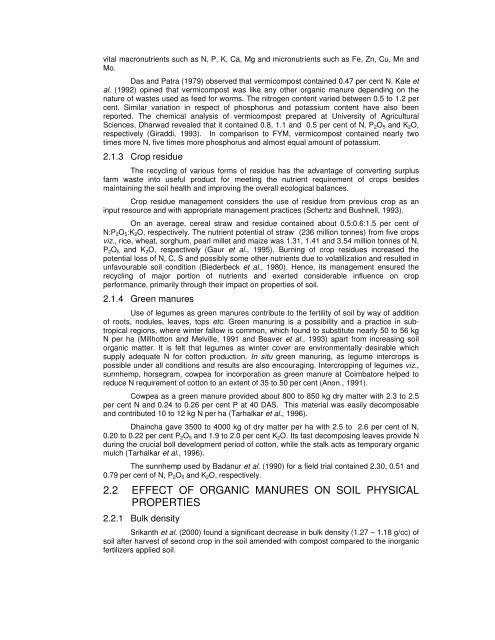impact of farmers' organic farming practices on soil properties in ...
impact of farmers' organic farming practices on soil properties in ...
impact of farmers' organic farming practices on soil properties in ...
Create successful ePaper yourself
Turn your PDF publications into a flip-book with our unique Google optimized e-Paper software.
vital macr<strong>on</strong>utrients such as N, P, K, Ca, Mg and micr<strong>on</strong>utrients such as Fe, Zn, Cu, Mn and<br />
Mo.<br />
Das and Patra (1979) observed that vermicompost c<strong>on</strong>ta<strong>in</strong>ed 0.47 per cent N. Kale et<br />
al. (1992) op<strong>in</strong>ed that vermicompost was like any other <str<strong>on</strong>g>organic</str<strong>on</strong>g> manure depend<strong>in</strong>g <strong>on</strong> the<br />
nature <str<strong>on</strong>g>of</str<strong>on</strong>g> wastes used as feed for worms. The nitrogen c<strong>on</strong>tent varied between 0.5 to 1.2 per<br />
cent. Similar variati<strong>on</strong> <strong>in</strong> respect <str<strong>on</strong>g>of</str<strong>on</strong>g> phosphorus and potassium c<strong>on</strong>tent have also been<br />
reported. The chemical analysis <str<strong>on</strong>g>of</str<strong>on</strong>g> vermicompost prepared at University <str<strong>on</strong>g>of</str<strong>on</strong>g> Agricultural<br />
Sciences, Dharwad revealed that it c<strong>on</strong>ta<strong>in</strong>ed 0.8, 1.1 and 0.5 per cent <str<strong>on</strong>g>of</str<strong>on</strong>g> N, P2O5 and K2O,<br />
respectively (Giraddi, 1993). In comparis<strong>on</strong> to FYM, vermicompost c<strong>on</strong>ta<strong>in</strong>ed nearly two<br />
times more N, five times more phosphorus and almost equal amount <str<strong>on</strong>g>of</str<strong>on</strong>g> potassium.<br />
2.1.3 Crop residue<br />
The recycl<strong>in</strong>g <str<strong>on</strong>g>of</str<strong>on</strong>g> various forms <str<strong>on</strong>g>of</str<strong>on</strong>g> residue has the advantage <str<strong>on</strong>g>of</str<strong>on</strong>g> c<strong>on</strong>vert<strong>in</strong>g surplus<br />
farm waste <strong>in</strong>to useful product for meet<strong>in</strong>g the nutrient requirement <str<strong>on</strong>g>of</str<strong>on</strong>g> crops besides<br />
ma<strong>in</strong>ta<strong>in</strong><strong>in</strong>g the <strong>soil</strong> health and improv<strong>in</strong>g the overall ecological balances.<br />
Crop residue management c<strong>on</strong>siders the use <str<strong>on</strong>g>of</str<strong>on</strong>g> residue from previous crop as an<br />
<strong>in</strong>put resource and with appropriate management <str<strong>on</strong>g>practices</str<strong>on</strong>g> (Schertz and Bushnell, 1993).<br />
On an average, cereal straw and residue c<strong>on</strong>ta<strong>in</strong>ed about 0.5:0.6:1.5 per cent <str<strong>on</strong>g>of</str<strong>on</strong>g><br />
N:P2O5:K2O, respectively. The nutrient potential <str<strong>on</strong>g>of</str<strong>on</strong>g> straw (236 milli<strong>on</strong> t<strong>on</strong>nes) from five crops<br />
viz., rice, wheat, sorghum, pearl millet and maize was 1.31, 1.41 and 3.54 milli<strong>on</strong> t<strong>on</strong>nes <str<strong>on</strong>g>of</str<strong>on</strong>g> N,<br />
P2O5 and K2O, respectively (Gaur et al., 1995). Burn<strong>in</strong>g <str<strong>on</strong>g>of</str<strong>on</strong>g> crop residues <strong>in</strong>creased the<br />
potential loss <str<strong>on</strong>g>of</str<strong>on</strong>g> N, C, S and possibly some other nutrients due to volatilizati<strong>on</strong> and resulted <strong>in</strong><br />
unfavourable <strong>soil</strong> c<strong>on</strong>diti<strong>on</strong> (Biederbeck et al., 1980). Hence, its management ensured the<br />
recycl<strong>in</strong>g <str<strong>on</strong>g>of</str<strong>on</strong>g> major porti<strong>on</strong> <str<strong>on</strong>g>of</str<strong>on</strong>g> nutrients and exerted c<strong>on</strong>siderable <strong>in</strong>fluence <strong>on</strong> crop<br />
performance, primarily through their <str<strong>on</strong>g>impact</str<strong>on</strong>g> <strong>on</strong> <strong>properties</strong> <str<strong>on</strong>g>of</str<strong>on</strong>g> <strong>soil</strong>.<br />
2.1.4 Green manures<br />
Use <str<strong>on</strong>g>of</str<strong>on</strong>g> legumes as green manures c<strong>on</strong>tribute to the fertility <str<strong>on</strong>g>of</str<strong>on</strong>g> <strong>soil</strong> by way <str<strong>on</strong>g>of</str<strong>on</strong>g> additi<strong>on</strong><br />
<str<strong>on</strong>g>of</str<strong>on</strong>g> roots, nodules, leaves, tops etc. Green manur<strong>in</strong>g is a possibility and a practice <strong>in</strong> subtropical<br />
regi<strong>on</strong>s, where w<strong>in</strong>ter fallow is comm<strong>on</strong>, which found to substitute nearly 50 to 56 kg<br />
N per ha (Millhott<strong>on</strong> and Melville, 1991 and Beaver et al., 1993) apart from <strong>in</strong>creas<strong>in</strong>g <strong>soil</strong><br />
<str<strong>on</strong>g>organic</str<strong>on</strong>g> matter. It is felt that legumes as w<strong>in</strong>ter cover are envir<strong>on</strong>mentally desirable which<br />
supply adequate N for cott<strong>on</strong> producti<strong>on</strong>. In situ green manur<strong>in</strong>g, as legume <strong>in</strong>tercrops is<br />
possible under all c<strong>on</strong>diti<strong>on</strong>s and results are also encourag<strong>in</strong>g. Intercropp<strong>in</strong>g <str<strong>on</strong>g>of</str<strong>on</strong>g> legumes viz.,<br />
sunnhemp, horsegram, cowpea for <strong>in</strong>corporati<strong>on</strong> as green manure at Coimbatore helped to<br />
reduce N requirement <str<strong>on</strong>g>of</str<strong>on</strong>g> cott<strong>on</strong> to an extent <str<strong>on</strong>g>of</str<strong>on</strong>g> 35 to 50 per cent (An<strong>on</strong>., 1991).<br />
Cowpea as a green manure provided about 800 to 850 kg dry matter with 2.3 to 2.5<br />
per cent N and 0.24 to 0.26 per cent P at 40 DAS. This material was easily decomposable<br />
and c<strong>on</strong>tributed 10 to 12 kg N per ha (Tarhalkar et al., 1996).<br />
Dha<strong>in</strong>cha gave 3500 to 4000 kg <str<strong>on</strong>g>of</str<strong>on</strong>g> dry matter per ha with 2.5 to 2.6 per cent <str<strong>on</strong>g>of</str<strong>on</strong>g> N,<br />
0.20 to 0.22 per cent P2O5 and 1.9 to 2.0 per cent K2O. Its fast decompos<strong>in</strong>g leaves provide N<br />
dur<strong>in</strong>g the crucial boll development period <str<strong>on</strong>g>of</str<strong>on</strong>g> cott<strong>on</strong>, while the stalk acts as temporary <str<strong>on</strong>g>organic</str<strong>on</strong>g><br />
mulch (Tarhalkar et al., 1996).<br />
The sunnhemp used by Badanur et al. (1990) for a field trial c<strong>on</strong>ta<strong>in</strong>ed 2.30, 0.51 and<br />
0.79 per cent <str<strong>on</strong>g>of</str<strong>on</strong>g> N, P2O5 and K2O, respectively.<br />
2.2 EFFECT OF ORGANIC MANURES ON SOIL PHYSICAL<br />
PROPERTIES<br />
2.2.1 Bulk density<br />
Srikanth et al. (2000) found a significant decrease <strong>in</strong> bulk density (1.27 – 1.18 g/cc) <str<strong>on</strong>g>of</str<strong>on</strong>g><br />
<strong>soil</strong> after harvest <str<strong>on</strong>g>of</str<strong>on</strong>g> sec<strong>on</strong>d crop <strong>in</strong> the <strong>soil</strong> amended with compost compared to the <strong>in</strong><str<strong>on</strong>g>organic</str<strong>on</strong>g><br />
fertilizers applied <strong>soil</strong>.

















